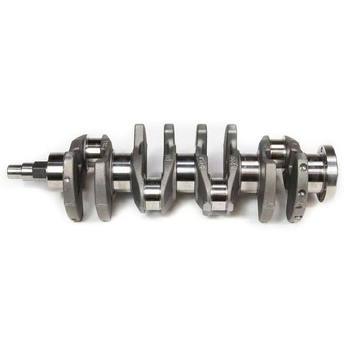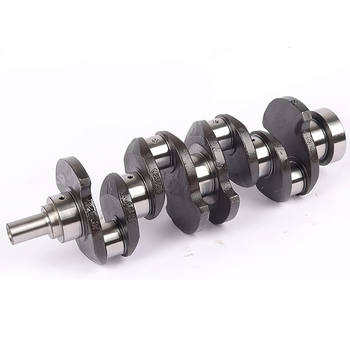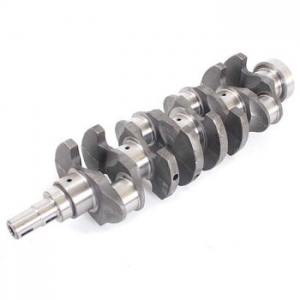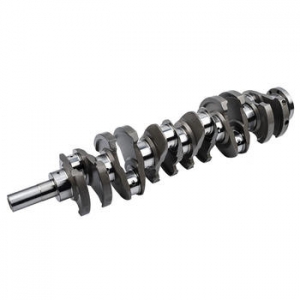Beyond Price: A Manufacturer\'s Deep-Dive into the True ROI of Premium Crankshafts
Views :
Update time : 2025-06-08
In the world of manufacturing, particularly when dealing with critical engine components, the initial purchase price often looms large as the primary decision-making factor. It’s a natural inclination, to be honest. Procurement teams are tasked with optimizing budgets, and a lower upfront cost can seem like an immediate win. However, in our experience, this narrow focus can be incredibly misleading, especially when it comes to components as vital as crankshafts. We’ve learned through years of production and countless hours of operational analysis that the true return on investment (ROI) for a premium crankshaft extends far beyond its sticker price.
But what if that initial saving is actually costing you more in the long run? This article is a deep-dive, from a manufacturer’s perspective, into understanding the multifaceted value proposition of premium crankshafts. We aim to peel back the layers of superficial cost analysis and illuminate the hidden savings, performance gains, and long-term strategic advantages that truly define the ROI of choosing quality over perceived economy. It’s about shifting the paradigm from 'what does it cost?' to 'what does it *deliver* over its lifetime?'
Understanding the Hidden Costs of "Cheaper" Crankshafts: A Manufacturer's Perspective on Price vs. Value
When we evaluate crankshafts, the temptation to opt for the lowest bidder is often strong. However, our company has consistently found that this approach almost invariably leads to a higher total cost of ownership. The initial price, as many experts agree, is merely the tip of the iceberg. Beneath the surface lie a myriad of hidden costs that quickly erode any perceived savings. Consider, for instance, the materials. A cheaper crankshaft might use inferior alloys or inconsistent heat treatment processes. While these shortcuts reduce manufacturing costs for the supplier, they significantly compromise the crankshaft's integrity. We’ve seen instances where such components exhibit premature wear, increased susceptibility to fatigue, and even catastrophic failure under normal operating conditions. This isn't just about a part breaking; it's about the ripple effect throughout the entire engine system and, ultimately, our end product. Then there are the manufacturing tolerances. Premium crankshafts are produced with incredibly tight specifications, ensuring perfect balance and minimal vibration. Cheaper alternatives often cut corners here, leading to slight imperfections that might seem negligible but accumulate over time. These imperfections can cause: * Increased friction within the engine, leading to higher fuel consumption. * Excessive vibration, which stresses other critical components like bearings, connecting rods, and even engine mounts, accelerating their wear. * Reduced power output and overall engine efficiency, directly impacting the performance of our machinery. Interestingly enough, the lack of rigorous testing is another significant differentiator. Reputable premium manufacturers invest heavily in advanced quality control, including non-destructive testing, metallurgical analysis, and dynamic balancing. This ensures that every crankshaft meets stringent performance and durability standards. Suppliers of cheaper alternatives often skip or minimize these crucial steps, passing on the risk directly to us, the manufacturer, and subsequently to our customers. The cost of a single field failure, including warranty claims, reputational damage, and logistical expenses, can easily dwarf the upfront savings of a dozen or even a hundred cheaper crankshafts. It's worth noting that these hidden costs are often difficult to quantify until they manifest as expensive problems.Durability and Longevity: The Cornerstone of True ROI in Premium Crankshafts
The most immediate and tangible aspect of a premium crankshaft's true ROI lies in its superior durability and extended longevity. This isn't just about a part lasting longer; it's about the profound impact on our product's overall lifespan, reliability, and customer satisfaction. Our company’s commitment to quality dictates that we prioritize components that can withstand the rigors of continuous operation, often under extreme conditions. At the heart of a premium crankshaft's durability is its material composition and manufacturing process. We often look for crankshafts forged from high-strength steel alloys, specifically designed for fatigue resistance and toughness. This contrasts sharply with cast crankshafts, which, while cheaper to produce, inherently possess lower strength and are more prone to cracking under stress. Furthermore, the precise heat treatment and surface hardening processes, such as nitriding or induction hardening, applied to premium crankshafts create a wear-resistant surface while maintaining a tough core. This combination significantly extends the component's operational life, reducing the need for premature replacements. Precision machining and balancing are equally critical. A premium crankshaft undergoes meticulous grinding, polishing, and balancing procedures. This ensures that every journal is perfectly round, every surface is incredibly smooth, and the entire assembly is balanced to within microns. The result is minimal friction, reduced stress concentrations, and virtually no vibration, all of which contribute directly to the crankshaft’s longevity and, by extension, the engine's overall health. When a crankshaft is perfectly balanced, it minimizes wear on main bearings and connecting rod bearings, which are often the first points of failure in an engine with an unbalanced or poorly manufactured crankshaft. The ROI here is clear: a crankshaft that lasts significantly longer translates directly into fewer warranty claims, reduced service intervals for our end-users, and a stronger reputation for product reliability. It means our products spend more time in operation and less time in the repair shop.
Operational Efficiency and Performance Gains: Unlocking Deeper Value Beyond Price
Beyond sheer durability, premium crankshafts contribute significantly to the operational efficiency and performance of the engines they power. This aspect of the true ROI is often overlooked when the focus remains solely on the purchase price. For us, as a manufacturer, these gains translate into a superior end product that offers tangible benefits to our customers, thereby strengthening our market position. One key area is reduced friction. Premium crankshafts feature highly polished bearing surfaces and optimized oil passages, which minimize resistance and allow for smoother rotation. Less friction means less energy loss in the form of heat, leading to improved fuel economy and greater power transfer to the drivetrain. In high-performance or heavy-duty applications, even a marginal improvement in efficiency can lead to substantial savings over the operational life of the equipment. We've observed that engines equipped with superior crankshafts consistently demonstrate better thermal management, which is crucial for long-term reliability. Weight optimization is another critical factor. Advanced manufacturing techniques allow premium crankshafts to be designed with optimal strength-to-weight ratios. Lighter crankshafts reduce rotational inertia, allowing the engine to rev more freely and respond more quickly to throttle inputs. This translates into improved acceleration and overall responsiveness, which is a significant performance advantage in many applications. Furthermore, reduced mass contributes to less stress on engine mounts and the chassis, extending the life of other components. Can you truly put a price on the peace of mind that comes with knowing your core engine component is built to perform under extreme conditions? The superior balancing of premium crankshafts also leads to significantly reduced vibration. This isn't just about comfort; it's about mechanical integrity. Excessive vibration can lead to premature wear on virtually every component connected to the engine, from engine mounts and exhaust systems to electrical sensors and even the vehicle's chassis. By mitigating vibration at its source, premium crankshafts contribute to a quieter, smoother running engine and a longer service life for the entire system. These performance enhancements directly translate into a more competitive product for our company, justifying the initial investment many times over.Mitigating Downtime and Maintenance Costs: The Unseen Savings of a Premium Investment
Perhaps the most compelling argument for the true ROI of premium crankshafts lies in their ability to drastically reduce costly downtime and ongoing maintenance expenses. This is where the initial price difference fades into insignificance compared to the financial impact of a component failure. For a manufacturing operation like ours, every hour of unplanned downtime for our machinery, or for our customers' machinery that uses our engines, represents a direct loss of revenue and productivity. A robust, durable premium crankshaft directly translates into fewer unexpected breakdowns. When a critical component like a crankshaft fails, it doesn't just mean replacing that single part. It often leads to extensive damage to other engine components, such as connecting rods, pistons, engine block, and cylinder heads. The repair then escalates from a simple part replacement to a full engine overhaul or even a complete engine replacement. The cost of these major repairs, including parts, specialized labor, and diagnostic time, can be astronomical. Beyond the direct repair costs, the indirect costs of downtime are often far greater. For our customers, an unexpected failure means their equipment is out of commission. This could be a truck unable to transport goods, a generator unable to supply power, or a piece of heavy machinery halting a construction project. The lost revenue, missed deadlines, and contractual penalties associated with this downtime can easily dwarf the price difference between a cheap and a premium crankshaft. In my experience, a single day of lost production for a key piece of equipment can cost tens of thousands of dollars, making the initial investment in a premium component a comparatively minor insurance policy. Furthermore, premium crankshafts contribute to more predictable maintenance schedules. Their inherent reliability means that routine maintenance can be planned and executed without the constant threat of unexpected failures. This allows our customers to optimize their operational efficiency and resource allocation. It also reduces the need for emergency repairs, which are typically more expensive due to expedited shipping of parts and overtime labor. The long-term savings in labor costs, spare parts inventory, and logistical overhead associated with fewer unscheduled repairs are a significant component of the true ROI. This is a crucial point for us, as it directly impacts our customers' bottom line and, by extension, their satisfaction with our products.
Reputation, Warranty, and Long-Term Partnership: The Strategic Value of Choosing Premium
The true ROI of premium crankshafts extends beyond the tangible benefits of durability, efficiency, and reduced maintenance. It encompasses strategic advantages that bolster our company's reputation, minimize warranty liabilities, and foster invaluable long-term partnerships. These are the intangible yet profoundly impactful elements that contribute to sustained business success. Firstly, using premium components directly enhances our own brand reputation. When our products consistently perform reliably and endure the test of time, it builds trust with our customers. This trust is an invaluable asset in a competitive market. Conversely, a string of failures due to subpar internal components can quickly erode customer confidence and lead to negative word-of-mouth, which is incredibly difficult to recover from. Many experts agree that a strong reputation for quality is a powerful differentiator, allowing us to command a premium for our products and secure repeat business. Secondly, the impact on warranty claims is significant. Every warranty claim represents a direct financial cost, involving parts, labor, logistics, and administrative overhead. More importantly, it represents a dissatisfied customer and a potential loss of future business. By integrating premium crankshafts, we significantly reduce the likelihood of engine-related failures, thereby decreasing the volume and cost of warranty claims. This not only saves us money but also frees up valuable resources that can be redirected towards innovation and growth. In my experience, the cost savings from reduced warranty payouts alone can often justify the investment in higher-quality components. Finally, choosing premium crankshafts often means forging long-term partnerships with reputable suppliers. These suppliers are not just vendors; they are collaborators who invest in research and development, offer superior technical support, and maintain stringent quality control. Working with such partners ensures a consistent supply of high-quality components, facilitates collaborative problem-solving, and provides access to cutting-edge advancements in material science and manufacturing processes. This strategic alignment can lead to innovations in our own product lines and provide a stable, reliable supply chain, which is critical for continuous production. It’s worth noting that these relationships often provide insights and support that a transactional, price-driven relationship simply cannot offer. This future-proofing aspect, ensuring our products remain competitive and reliable, is a vital component of the true ROI. In conclusion, while the initial price of a crankshaft is an undeniable factor in procurement decisions, a comprehensive understanding of its true ROI demands a much broader perspective. It is clear that investing in premium crankshafts is not merely an expense; it is a strategic decision that underpins long-term success and profitability. From enhancing durability and boosting operational efficiency to mitigating costly downtime and safeguarding our brand reputation, the benefits far outweigh the upfront cost. By embracing this holistic view, manufacturers can make informed choices that lead to superior products, increased customer satisfaction, and a stronger, more sustainable business model.For more detailed information, please visit our official website:Premium crankshafts ROI
About the author: Dr. Evelyn Reed is a seasoned Mechanical Engineer with over two decades of experience in powertrain development and manufacturing optimization. Specializing in critical engine components, her work focuses on the intersection of material science, precision engineering, and long-term operational efficiency. Dr. Reed is a passionate advocate for value-based procurement, guiding manufacturers to look "beyond price" to unlock the true ROI of premium industrial components.
Related News
Read More >>
 Trusted Crankshaft Manufacturi
Trusted Crankshaft Manufacturi
06 .17.2025
Discover expert crankshaft manufacturing services. We offer high-quality, precision-engineered crank...
 Trusted Crankshaft Supplier |
Trusted Crankshaft Supplier |
06 .17.2025
Leading Crankshaft supplier offering high-quality, durable crankshafts for all applications. We supp...
 Trusted Crankshaft Manufacture
Trusted Crankshaft Manufacture
06 .17.2025
Leading crankshaft manufacturer offering precision-engineered components for diverse applications. T...
 Trusted Crankshaft company Man
Trusted Crankshaft company Man
06 .16.2025
Discover our premium Crankshaft company solutions. As a trusted manufacturer, we offer high-quality ...
